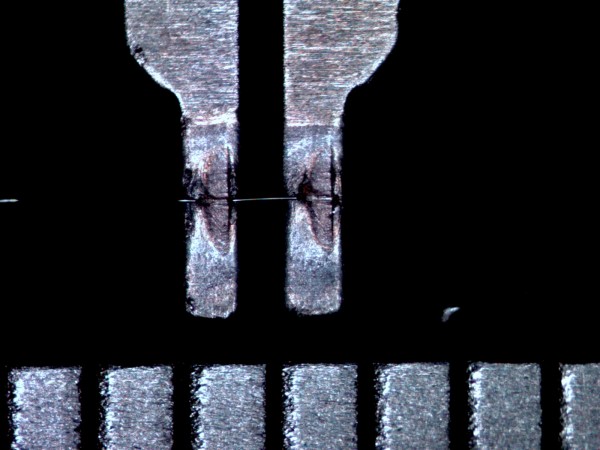
When most people hear the word “welding” they think of the guy in the local garage with an arc welder and a mask, or the army of spot welding robots used to build a car body. You might be surprised to learn that there are many more welds in the sensors and motors in a typical car than are used to hold the body together. These include welds for the electric motors used for windows, door locks, and seat adjustments, as well as the sensors for engine emission, fuel level, and various lights and switches.
These welds are all “small-scale” welds, generally meaning the materials are less than a half millimeter in thickness, and are dissimilar welds; i.e. a copper wire to a nickel-plated brass terminal, or gold bonds to a microelectronic circuit.
In other electronics, like cell phones, laptops, and digital music players, much of the assembly of the electrical components is done with soldering. Soldering is a great technology for assembling circuit boards. The circuit board-to-battery, antenna, and other components are all soldered by hand or a specialized machine, but in today’s world, with ever-shrinking device sizes, the solder joint requires a major amount of “real estate” as there is a practical lower-limit to pad size. The main reasons for this are the limitations of robotic soldering equipment, ability for a person to reliably solder something less than 100 microns in size, and requirement of a solder fillet.
An option favored by many electronic device manufacturers is to weld the fine wires to assemble the device. Welding has many advantages over soldering: is it much faster (several welds per second vs. more than one second per solder joint), uses no consumables (no solder, no flux) and can be monitored for in-process quality control. Welding can be accomplished with resistance welding or ultrasonic metal welding.
In the past few months we have completed some projects to replace soldering in some electronic devices. The photo below shows a bridge wire for a pyrotechnic detonator.

The scale at the bottom of the photo is in mm. The wire spanning the two vertical legs is about 25 microns in diameter. This assembly is produced in the millions per year and is a single-use device. Soldering can be used to solder the wire, but the solder joint can bridge between the vertical legs, or more importantly, varying solder volumes affects the resistance of the wire. This, in turn, varies the “fusing current” and therefore can throw off the precise timing required for detonating the pyrotechnics. A resistance welding process was developed to precisely weld the wire at each end, producing a repeatable resistance in the joint. An additional, important benefit was the ability to monitor weld current, force, and electrode displacement for each weld. This provided in-process weld quality data and confidence that each and every weld was consistent.
Another application was the need of one of our clients to join a thin film of titanium to a platinum wire. This very specialized medical device application was very limited in the selection of materials, and the small pads needed to be produced at specific intervals along the wire’s length. Soldering was not an option as it would have added a non-biocompatible metal, and increased the overall size of the assembly. The titanium film was vapor-deposited on a glass slide, which was intended to be etched away later. Parallel-gap resistance welding was developed to resistance braze the platinum to the titanium film. A photo of the braze joints are shown here:
In the above photo, the silver wire runs left-to-right, and is 75 microns in diameter, and the titanium thin film is about 10 microns. Two braze joints are shown in this photo.
This article explained some benefits of welding over soldering for small-scale joining, using a couple of application examples. EWI has worked on a number of other applications, and would be pleased to discuss the potential of replacing your challenging soldering application with an appropriate welding solution.
